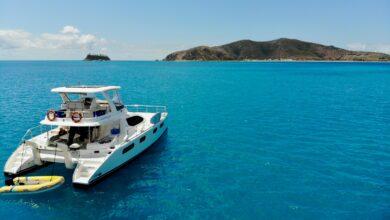🌴🚢 Digital Nomads and Remote Work Aboard: The Rise of Working While Cruising 🚢🌴
Sailing into the Future: The Emergence of Remote Work on Cruise Ships

Introduction
The world of work is changing, and it’s no longer confined to stuffy cubicles or corner offices. In recent years, a new kind of professional has emerged—one who ditches the 9-to-5 grind in favor of a laptop, a sense of adventure, and the open sea. They’re the digital nomads, and they’re rewriting the rules of remote work, taking it to places you’ve never imagined. Welcome to a world where work and wanderlust seamlessly collide—working while cruising.
In this article, we dive into the exhilarating world of digital nomads who have decided that office views just aren’t enough. They’re taking their work to sea, embracing the freedom of remote work while exploring new horizons. What was once a dream is now a reality, thanks to the evolution of technology, connectivity, and the rising popularity of remote-friendly cruise ships.
Whether you’re a seasoned digital nomad or someone considering the possibility of working while cruising, join us as we set sail on a journey to discover this inspiring and evolving lifestyle. It’s a world where remote work is synonymous with adventure, where office spaces give way to ocean vistas, and where deadlines are met under the gentle sway of the sea.
The Digital Nomad Lifestyle
What it Means to be a Digital Nomad and Work Remotely
In today’s interconnected world, the digital nomad lifestyle has gained immense popularity. But what exactly does it mean to be a digital nomad and work remotely? Simply put, digital nomads are individuals who leverage technology to work from various locations, often while traveling. This lifestyle allows them to break free from the constraints of a traditional office job, replacing it with a more flexible and location-independent work arrangement. Digital nomads typically rely on their laptops and internet connections to perform their job duties, whether as freelancers, remote employees, or entrepreneurs.
The digital nomad lifestyle is all about embracing the freedom to choose where and when you work. Whether it’s from a beachfront cafe in Bali, a co-working space in Barcelona, or the comfort of your own home, remote work offers the autonomy to design your ideal work environment. It’s an enticing blend of work and adventure, enabling individuals to explore new cultures and create a work-life balance that suits their needs.
The Benefits of Remote Work and Flexibility
The allure of remote work and flexibility is not without its merits. There are several key benefits to this lifestyle:
- Work-Life Balance: Remote work allows for greater control over your daily schedule. You can better balance your professional and personal life, ensuring that you have time for family, hobbies, and relaxation.
- Geographic Freedom: Digital nomads are not tied to a specific location, enabling them to live in places they love or explore new destinations. This flexibility is especially appealing to those who enjoy traveling.
- Cost Savings: Commuting costs, work attire expenses, and dining out during lunch breaks can add up. Working remotely often means substantial cost savings, increasing your disposable income.
- Increased Productivity: Many individuals find they are more productive when working in a comfortable environment of their choosing. Remote work allows for a personalized workspace tailored to your needs.
- Diverse Job Opportunities: The digital nomad lifestyle opens doors to a vast array of job opportunities. You can work for companies worldwide, tap into a global client base if you’re a freelancer, or even start your own online business.
The Evolution of Remote Work Aboard
The Shift Toward Working While Cruising and Exploring New Destinations
In recent years, there has been a remarkable evolution in the way people work remotely, with an exciting twist – the fusion of work and leisure while cruising and exploring new destinations. This shift represents a departure from traditional remote work setups, and it’s gaining popularity for a multitude of reasons.
The idea of working while cruising is about breaking free from the monotony of conventional office spaces and immersing oneself in the beauty and culture of diverse locations. Individuals are no longer tethered to their home offices or co-working spaces. Instead, they are choosing to set sail on cruise ships, which serve as both a workspace and a gateway to new experiences. This trend showcases a desire for work-life integration, allowing remote workers to extend their “office” to breathtaking coastal destinations.
The benefits are clear – a panoramic sea view becomes the backdrop for Zoom calls, and downtime can be spent exploring exotic ports of call. This shift caters to those seeking adventure and new horizons while maintaining a career, all made possible by the wonders of technology.
The Rise of Remote-Friendly Cruise Ships and Services
As the demand for working while cruising grows, the cruise industry has adapted by offering a range of remote-friendly cruise ships and services. These innovations are designed to provide a seamless blend of work and leisure for passengers.
Remote-friendly cruise ships are equipped with high-speed internet connectivity, co-working spaces, and dedicated business centers. These amenities ensure that travelers can stay connected, attend virtual meetings, and meet deadlines without compromising productivity. Additionally, some cruise lines offer curated itineraries that cater to remote workers, with extended stays in port cities and flexible disembarkation options.
Cruise services have also evolved to accommodate the remote workforce. Services such as virtual concierge apps, digital check-in, and contactless payments enhance the convenience of working from the ship. Cruise lines are partnering with digital nomad communities and co-working providers to offer special packages and discounts for remote workers, making this lifestyle more accessible and appealing.
Setting Sail: Working While Cruising
Explore the Advantages of Working While Cruising
Setting sail while working might sound like a dream come true, and for many, it certainly is. There are numerous advantages to working while cruising that go beyond the allure of breathtaking ocean views and exotic ports of call.
- Work-Life Balance: One of the most compelling aspects of remote work on a cruise is the enhanced work-life balance. The ocean’s serene backdrop, coupled with the freedom to explore new destinations during downtime, fosters a unique equilibrium. This setup enables professionals to maintain their career while embracing a more relaxed and adventurous lifestyle.
- Inspiration and Creativity: The constant change of scenery and immersion in different cultures can be a wellspring of inspiration. The diversity of experiences can spark creativity, making it an ideal setting for those in creative fields. Whether you’re a writer, artist, or entrepreneur, cruising can provide the ideal environment to fuel your creativity.
- Community and Networking: Many cruise lines have started catering to remote workers by offering co-working spaces and organizing networking events. This can be a great way to meet like-minded individuals, expand your professional network, and even collaborate on exciting projects while sailing the high seas.
Discuss the Challenges and Practical Considerations of Remote Work at Sea
While the idea of working while cruising is undeniably appealing, it’s important to recognize the challenges and practical considerations associated with remote work at sea.
- Internet Connectivity: Perhaps the most significant challenge is the reliability of internet connectivity. While many cruise ships now offer high-speed internet, it can be inconsistent, especially when sailing in remote or international waters. Remote workers must plan their tasks accordingly and be prepared for possible interruptions.
- Time Zone Differences: Navigating different time zones can be a logistical hurdle. Coordinating meetings and deadlines with colleagues or clients back on land may require careful scheduling and time management.
- Space and Ergonomics: Cabins on cruise ships are typically smaller than a traditional home office. Finding a comfortable workspace with suitable ergonomics can be a challenge. This means that remote workers might need to adapt and prioritize their physical well-being.
- Cost Considerations: Cruising, while an appealing concept, can be a significant financial commitment. Remote workers should carefully consider the costs associated with cruise fares, accommodations, and any additional expenses for onboard amenities and excursions.

Destination Independence
Showcase Some of the Beautiful and Unique Cruise Destinations That Appeal to Digital Nomads
Cruise destinations can offer a plethora of unique and beautiful locations that are a dream come true for digital nomads seeking adventure and inspiration. Here are some cruise destinations that appeal to those craving destination independence:
- The Greek Islands: Cruising through the stunning Greek Islands allows remote workers to immerse themselves in a rich tapestry of history, culture, and natural beauty. From the iconic Santorini with its cliffside villages to the picturesque beaches of Mykonos, the Greek Islands provide a captivating backdrop for remote work.
- Alaskan Wilderness: For those who prefer a more rugged and nature-focused experience, Alaskan cruises are a perfect choice. Imagine working from a ship’s deck while witnessing glaciers, fjords, and diverse wildlife. The pristine landscapes of Alaska offer a serene work environment unlike any other.
- Caribbean Paradise: The Caribbean is a perennial favorite for cruisers and digital nomads alike. The crystal-clear waters, palm-fringed beaches, and vibrant local cultures make it an ideal destination for combining work with leisure. From Barbados to the Cayman Islands, the Caribbean offers a range of captivating experiences.
- Norwegian Fjords: Norway’s dramatic fjords provide a breathtaking setting for remote work. The serene beauty of the Norwegian landscape, with its towering cliffs and picturesque villages, can be a remarkable source of inspiration for creative professionals.
Share Stories and Experiences of Remote Workers Aboard Cruise Ships
Digital nomads who have taken to the high seas while working have incredible stories and experiences to share. These firsthand accounts shed light on the real-world challenges and joys of working while cruising:
- Unforgettable Encounters: Remote workers often recount memorable encounters with fellow cruisers. These chance meetings can lead to lasting friendships and valuable connections in both personal and professional spheres.
- Balancing Act: The stories often emphasize the importance of a delicate work-life balance. Remote workers share their strategies for managing time zones, workload, and making the most of their destination exploration.
- Embracing Flexibility: Cruise ship experiences highlight the importance of flexibility in a remote work setting. Adaptability is key, as internet connectivity may vary, and schedules need to accommodate the ever-changing environment.
- Inspiration Abounds: Many remote workers speak of the profound inspiration they draw from the diverse destinations they visit. Working from a cruise ship offers a unique perspective, and the stories they tell often include moments of creativity sparked by the beauty of their surroundings.
Technology and Connectivity
Explain the Role of Technology and Connectivity in Making Remote Work at Sea Possible
The key to successful remote work at sea lies in the robust integration of technology and reliable connectivity. Without these elements, the dream of working while cruising would remain just that. Here’s a breakdown of their essential roles:
- High-Speed Internet: The backbone of remote work at sea is a stable and high-speed internet connection. Cruise ships have made significant investments in satellite technology to provide connectivity in the middle of the ocean. This ensures that remote workers can access emails, video conferencing platforms, and cloud-based tools seamlessly.
- Virtual Private Networks (VPNs): To maintain data security and privacy, remote workers often rely on VPNs. These encrypted networks allow them to connect to their work servers securely, even while sailing the high seas.
- Satellite Communication: Cruise ships use advanced satellite communication systems to maintain constant contact with the outside world. This technology is vital for both communication and navigation. It enables passengers to access the internet and make calls from virtually anywhere on the ship.
- Cloud-Based Tools: Remote work heavily relies on cloud-based tools and platforms. These tools enable digital nomads to collaborate, share files, and access critical data from various locations. Whether it’s Google Workspace, Microsoft 365, or other cloud services, these tools are essential for productivity.
Provide Tips for Ensuring a Smooth Remote Work Experience While Cruising
While technology and connectivity make remote work at sea possible, here are some tips to ensure a smooth and productive experience:
- Choose the Right Cruise Line: Research cruise lines that are known for their remote work-friendly amenities and connectivity. Some cruise companies cater specifically to digital nomads, providing reliable Wi-Fi, co-working spaces, and even dedicated business centers.
- Plan Ahead: Before embarking on a cruise, inform your colleagues or clients about your remote work schedule and the potential for different time zones. Clear communication and setting expectations are crucial.
- Test Connectivity: Upon boarding, test the ship’s internet connectivity and identify the best spots for a strong signal. Be prepared for fluctuations in speed and reliability and adjust your work schedule accordingly.
- Backup Solutions: Carry backup solutions for internet access, such as a portable hotspot or a local SIM card. These can be lifesavers if the ship’s connectivity encounters unexpected issues.
- Time Management: Effective time management is essential. Be disciplined in setting work hours and stick to your schedule. Allocate specific times for work and leisure to maintain a healthy work-life balance.
- Ergonomics: Create a comfortable and ergonomic workspace within your cabin. Invest in a good chair and monitor stand if possible to reduce physical strain.
- Data Security: Always prioritize data security. Use a VPN to protect your data, avoid public Wi-Fi networks, and follow best practices for safeguarding your work-related information.
Future Trends and Possibilities
Discuss the Future of Remote Work Aboard Cruise Ships and Potential Innovations
The future of remote work aboard cruise ships holds exciting possibilities, driven by evolving technology and changing work dynamics. Here’s a glimpse into what lies ahead:
- Enhanced Connectivity: Cruise lines are likely to continue investing in improving internet connectivity. We can expect faster and more reliable connections, making remote work at sea even smoother. Some cruise companies might explore partnerships with satellite internet providers to offer cutting-edge solutions.
- Dedicated Remote Work Cruises: The future may see cruise lines offering dedicated remote work cruises. These voyages could cater specifically to digital nomads, with extended stays in picturesque locations, tailored co-working spaces, and networking opportunities. It would create a unique work-travel ecosystem.
- Innovative Workspaces: Cruise ships may incorporate innovative co-working spaces with ergonomic design, high-tech amenities, and even augmented reality environments. These spaces would offer a blend of productivity and inspiration for remote workers.
- Digital Nomad Communities: We might witness the growth of digital nomad communities on cruise ships. Like-minded individuals could come together to share experiences, skills, and ideas. This could lead to the formation of nomadic work collectives.
- Virtual Reality (VR) Integration: The integration of VR technology on cruise ships could transport remote workers to virtual offices with breathtaking ocean views. This immersive experience would further enhance the appeal of working while cruising.
Explore How This Trend Could Impact the Travel Industry
The rise of remote work aboard cruise ships has the potential to transform the travel industry in several ways:
- Cruise Line Diversification: Cruise companies might diversify their offerings to include niche cruises targeting remote workers. This shift could help them tap into a new market segment, boosting revenue and overall cruise popularity.
- Increased Cruise Popularity: The availability of remote work options could attract a broader range of passengers. Individuals who previously may not have considered cruising as a vacation choice might be drawn to the idea of blending work and leisure on the high seas.
- Destination Expansion: As remote work aboard cruise ships gains momentum, we can anticipate cruise lines expanding their itineraries to cover more destinations, including lesser-explored regions. This can contribute to the economic development of these areas.
- Technological Advancements: The travel industry would likely see technological advancements in areas like satellite communications, digital concierge services, and remote work infrastructure. These innovations would not only benefit cruise ships but also influence technology trends in other sectors.
- Hybrid Travel Packages: Travel agencies may start offering hybrid packages that combine traditional land-based travel with cruise segments to cater to the growing demand for remote work experiences at sea.
FAQs
Q: What types of jobs are suitable for digital nomads?
A: Digital nomads come from various professions, including writers, designers, programmers, and marketers.
Q: How do I handle time zone differences while working remotely?
A: Time zone management apps and clear communication with employers can help mitigate these challenges.
Q: Are there any downsides to being a digital nomad?
A: Potential downsides include loneliness, lack of routine, and navigating visa and tax issues. However, these can be managed with proper planning.
Q: Can digital nomads work from any cruise ship?
A: Most modern cruise ships are equipped for remote work, but it’s essential to research their connectivity options.
Q: How do I get started as a digital nomad?
A: Begin by identifying your skills, securing remote work opportunities, and selecting your first cruise destination.
Q: Is working while cruising suitable for families?
A: Yes, many families choose to embark on digital nomad adventures, providing unique educational opportunities for their children.
Conclusion
The rise of working while cruising is a testament to the changing landscape of work, travel, and adventure. The digital nomads who’ve embraced this lifestyle have shown that the world is their office, and they’re taking full advantage of the opportunities it provides.
As we conclude this exploration of working while cruising, we hope you’ve been inspired by the possibilities of remote work at sea. The freedom to choose your office view, the exhilaration of exploring new destinations, and the work-life balance it offers are alluring prospects. It’s a lifestyle where productivity meets passion, and where adventure is just a ship away.
So, whether you’re an aspiring digital nomad or someone looking to add a touch of adventure to your work life, remember that the world is yours to explore. The rise of working while cruising invites you to embrace the freedom, seek new horizons, and chart your course toward a life of meaningful work and unforgettable adventures.
UP NEXT
Exploring the Charming Medieval Town of Terrasson-Lavilledieu in France





Facebook Comments